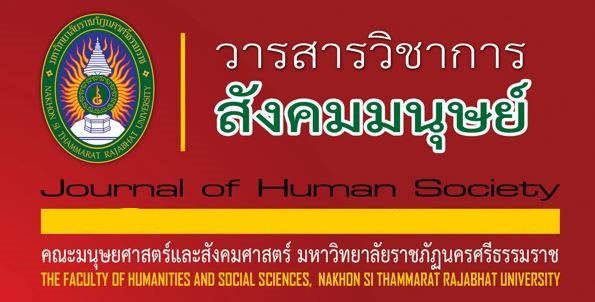อิทธิพลของส่วนประสมการตลาดต่อพฤติกรรมนักท่องเที่ยวในการสนับสนุน การท่องเที่ยวทางรถไฟ ณ เขาหลวง จังหวัดนครศรีธรรมราช
Main Article Content
บทคัดย่อ
การศึกษาครั้งนี้มีวัตถุประสงค์เพื่อศึกษาผลของอิทธิพลของส่วนประสมการตลาดที่มีต่อพฤติกรรมนักท่องเที่ยวในการสนับสนุนการท่องเที่ยวทางรถไฟ ณ เขาหลวง จังหวัดนครศรีธรรมราช โดยใช้วิธีการวิจัยเชิงปริมาณ กลุ่มตัวอย่างคือ นักท่องเที่ยวชาวไทยที่เดินทางด้วยรถไฟมายังพื้นที่เขาหลวง จำนวน 387 คน ซึ่งได้จากการสุ่มแบบบังเอิญเครื่องมือที่ใช้ในการเก็บรวบรวมข้อมูลคือแบบสอบถาม สถิติที่ใช้ในการวิเคราะห์ข้อมูลใช้สถิติเชิงพรรณนาและสถิติเชิงอนุมาน
ผลการศึกษาพบว่า ปัจจัยส่วนประสมการตลาดทุกด้านมีค่าเฉลี่ยความพึงพอใจในระดับสูง โดยเฉพาะด้านบุคลากร (Mean = 4.60) และสภาพแวดล้อมทางกายภาพ (Mean = 4.44) ส่งผลต่อการตัดสินใจเดินทางท่องเที่ยวอย่างมีนัยสำคัญทางสถิติที่ระดับ 0.05 โดยผลการถดถอยพหุคูณชี้ว่า ปัจจัยที่มีอิทธิพลสูงสุดต่อการตัดสินใจคือ สภาพแวดล้อมทางกายภาพ (β = 0.435) รองลงมาคือ ราคา (β = 0.421) และผลิตภัณฑ์การท่องเที่ยว (β = 0.315) ผลการเปรียบเทียบยังพบว่า ระดับการศึกษามีความแตกต่างในการตัดสินใจใช้งานรถไฟอย่างมีนัยสำคัญ ในขณะที่ปัจจัยอื่น ๆ เช่น เพศ อายุ อาชีพ และรายได้ ไม่มีผลแตกต่าง
การศึกษานี้สะท้อนให้เห็นว่าการวางกลยุทธ์การตลาดโดยเน้นองค์ประกอบที่สำคัญสามารถยกระดับประสบการณ์การเดินทางด้วยรถไฟ และสนับสนุนการพัฒนาแหล่งท่องเที่ยวในระดับภูมิภาคอย่างยั่งยืน
Article Details

อนุญาตภายใต้เงื่อนไข Creative Commons Attribution-NonCommercial-NoDerivatives 4.0 International License.
บทความที่ได้รับการตีพิมพ์จะเป็นลิขสิทธิ์ของวารสารวิชาการสังคมมนุษย์
เอกสารอ้างอิง
Brown, A., & Davis, E. (2023). Infrastructure and tourism in Southeast Asia: Thailand’s strategic approach. Journal of Travel Research, 42(4), 350–365.
Brown, J. (2020). The gateway to the past: Architectural significance of Thai railway stations. Journal of Historical Architecture, 15(2), 89–104.
Davis, M. (2021). Cultural reflections in tourism: The case of Nakhon Si Thammarat. Southeast Asian Cultural Studies, 33(1), 45–60.
George, D., & Mallery, P. (2003). SPSS for Windows step by step: A simple guide and reference. 11.0 update (4th ed.). Allyn & Bacon.
Johnson, S., & Lee, K. (2022). Visual engagement and tourist perception. Visual Anthropology Review, 38(1), 34–50.
Jones, M. (2022). Tradition meets modernity: The dual appeal of Thai tourism. Asian Studies Review, 46(1), 99–114.
Kim, H., & Park, J. (2023). The role of the journey in tourism. International Journal of Travel Research, 25(4), 401–415.
Kusonkhum, W., Srinavin, K., Leungbootnak, N., & Chaitongrat, T. (2022). Using a machine learning approach to predict the Thailand underground train’s passenger. Journal of Advanced Transportation, 2022(1), Article 8789067.
Olsen, E. (2022). Anticipation in travel: Enhancing destination satisfaction. Travel Psychology Journal, 34(1), 56–73.
Pasaco-González, B. S., Campón-Cerro, A. M., Moreno-Lobato, A., & Sánchez-Vargas, E. (2023). The role of demographics and previous experience in tourists’ experiential perceptions. Sustainability, 15(4), Article 3768.
Peterson, D., & Nguyen, T. (2023). Modes of travel and tourist behavior. Tourism Analysis, 28(3), 300–315.
Piboonrungroj, P., Wannapan, S., & Chaiboonsri, C. (2023). The impact of gastronomic tourism on Thailand economy: Under the situation of COVID-19 pandemic. SAGE Open, 13(1), Article 21582440231154803.
Phukamchanoad, P. (2020). The model of public participation in social development based on the philosophy of sufficiency economy affecting paddy fields and rock salt fields in Ban Dung District, Udon Thani Province, Thailand. Phranakhon Rajabhat Research Journal: Humanities and Social Sciences, 15(1), 293–312.
Phuthong, T., Anuntavoranich, P., Chandrachai, A., & Piromsopa, K. (2023). A framework for assessing wellness tourism destination competitiveness: A perspective from the wellness tourism clusters in Thailand. GeoJournal of Tourism & Geosites, 49(3).
Smith, J. (2021). Sustainability and adaptability in Thai tourism. Journal of Sustainable Tourism, 39(6), 1045–1060.
Sann, R., Jansom, S., & Muennaburan, T. (2024). An extension of the theory of planned behaviour in Thailand cycling tourism: The mediating role of attractiveness of sustainable alternatives. Leisure Studies, 43(1), 47–61.
Sophon, V. (2022). Study of tourist behavior traveling in Chiang Mai Province. In Proceedings of the Graduate School Conference (Vol. 4, No. 1, p. 318).
Srisawat, P., Zhang, W., Sukpatch, K., & Wichitphongsa, W. (2023). Tourist behavior and sustainable tourism policy planning in the COVID-19 era: Insights from Thailand. Sustainability, 15(7), Article 5724.
Tantivejakul, N. (2024). The State Railway of Siam and the origin of tourism public relations in Thailand (1917–1941). Corporate Communications: An International Journal, 29(1), 9–23.
Taylor, R. (2021). Community and connection: Performative aspects of tourism. Sociology of Travel, 10(2), 134–150.
Thaothampitak, W., Wongsuwatt, S., & Choibamroong, T. (2024). The influence of key success factors on business growth for tourism business along Thailand’s Andaman coast: Moderating role of location. Tourism and Hospitality Management, 29(2), 134–150. https://dx.doi.org/10.20867/thm.29.2.4
Waiyawet, S., & Nonthapot, S. (2023). Demand for water tourism by rafting in the upper northeastern region 1 of Thailand. Journal of Environmental Management and Tourism, 14(4), 2056–2065.
Wang, L. (2022). Environmental impacts of rapid tourism expansion in Thailand. Environmental Science & Policy, 33(3), 175–189.
Wilson, G. (2023). Sensory experiences in rail travel to Khao Luang. Annals of Tourism Research, 50(1), 88–102.
Yodkhayan, M., & Muneenam, U. (2023). Evaluation of community-based gastronomic tourism in Satun Province, Thailand, regarding management for zero food waste. GeoJournal of Tourism and Geosites, 50(4), 1260–1267.


